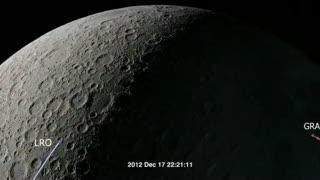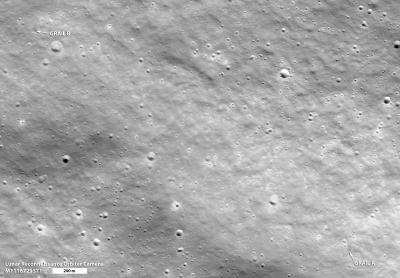Mercury is a volatile, or easily vaporized, substance. Scientists propose that it could accumulate in cold, permanently shadowed craters like the one targeted for the LCROSS impact, but it was a surprise to see that it was also in an area that gets regular sunlight. "The issue for the GRAIL impact was not so much that mercury was found – you would expect it to be present as an element from the moon's formation, just like it is found on Earth," said Keller. "Rather, it is still reasonably concentrated near the surface instead of being driven off in an area where, for a very long time, the surface has been completely exposed to the space environment, including heat from the Sun, impacts from microscopic meteorites, and radiation."
"These new results help us continue to understand the nature of volatiles near the lunar poles," says Kurt Retherford, LAMP principal investigator at Southwest Research Institute, San Antonio, Texas. "In the last four years we have begun to understand that the amount of water ice near the polar regions is higher than previously thought. In addition to direct measurements of water from the LCROSS impact plume there were several other volatile species detected in the Cabeus crater cold-trapping region, including mercury atoms and hydrogen (H2) molecules detected with the LAMP instrument. While our results are still very new, our thinking is that the mercury detected by LAMP from the GRAIL site might be related to an enhancement at the poles caused by mercury atoms generally hopping across the surface and eventually migrating toward the colder polar regions. The detection of hydrogen atoms from the GRAIL impact plumes compared with H2 molecules in the LCROSS impact plume might tell us more about hydrogen and/or water near the poles, but this is a work in progress."
"This gives insight into how volatile material is transported around the moon," adds Keller. "It gives us a data point that helps constrain models of volatile transport, especially for models that describe how volatile material can get transported from warm to cold areas on the moon."
LRO's Lunar Reconnaissance Orbiter Camera (LROC) was able to make an image of the craters from the GRAIL impacts despite their relatively small size.
"The two spacecraft were relatively small -- cubes about the size of a washing machine with a mass of about 200 kg (440 lbs.) each at the time of impact," said Mark Robinson, LROC principal investigator at Arizona State University's School of Earth and Space Sciences, Tempe, Ariz. "When they were launched, the individual spacecraft mass was slightly more than 300 kg (661 lbs.), but each consumed just over 100 kg of fuel during the mission. The spacecraft were traveling about 6,070 kilometers per hour (3,771 mph) when they hit the surface. Both craters are relatively small, perhaps 4 to 6 meters (about 13 to 20 feet) in diameter and both have faint, dark, ejecta patterns, which is unusual. Fresh impact craters on the moon are typically bright, but these may be dark due to spacecraft material being mixed with the ejecta."
"Both impact sites lie on the southern slope of an unnamed massif (mountain) that lies south of the crater Mouchez and northeast of the crater Philolaus," adds Robinson. "The massif stands as much as 2,500 meters (about 8,202 feet) above the surrounding plains. The impact sites are at an elevation of about 700 meters (around 2,296 feet) and 1,000 meters (3,281 feet), respectively, about 500 to 800 meters (approximately 1,640 to 2,625 feet) below the summit. The two impact craters are about 2,200 meters (roughly 7,218 feet) apart. GRAIL B (renamed Flow) impacted about 30 seconds after GRAIL A (Ebb) at a site to the west and north of GRAIL A."
"The LRO spacecraft team, with much help and input from the GRAIL navigation team, did an excellent job of tailoring the timing of the LRO spacecraft's passage nearest the impact site to coincide with the impact events and needed delays for the plumes to rise up into sunlight," said Retherford. "Our two spacecraft teams communicated well with one another, which was crucial to making this coordinated observation a success."
LRO complemented the GRAIL mission in other ways as well. LRO's Diviner lunar radiometer observed the impact site and confirmed that the amount of heating of the surface there by the relatively small GRAIL spacecraft was within expectations. LRO's Lunar Orbiter Laser Altimeter (LOLA) instrument bounced laser pulses off the surface to build up a precise map of the lunar terrain, including the three-dimensional structure of features like mountains and craters. "Combining the LRO LOLA topography map with GRAIL's gravity map yields some very interesting results," said Keller. "You expect that areas with mountains will have a little stronger gravity, while features like craters will have a little less. However, when you subtract out the topography, you get another map that reveals gravity differences that are not tied to the surface. It gives insight into structures deeper in the moon's interior."

On Dec. 17, 2012, NASA's twin GRAIL spacecraft were deliberately crashed into the lunar surface traveling at nearly 4,000 mph. Another NASA spacecraft, Lunar Reconnaissance Orbiter, observed the impact using its LAMP instrument. The vertical rectangle in the animation represents the field-of-view of the LAMP instrument as determined by a thin slit-like aperture. LAMP is an imaging spectrometer so when looking directly down the slit sweeps across the lunar surface in what is call push-broom technique. The spacecraft rolled off to the side to put the slit on the lunar horizon. The LRO spacecraft crossed over the impact site at the right time for the first plume to get into the LAMP field-of-view.
(Photo Credit: NASA/GSFC/Ernest Wright/Dan Gallagher)

This image shows the LRO LROC before-and-after view of GRAIL impacts.
(Photo Credit: NASA/GSFC/Arizona State University)
Source: NASA/Goddard Space Flight Center